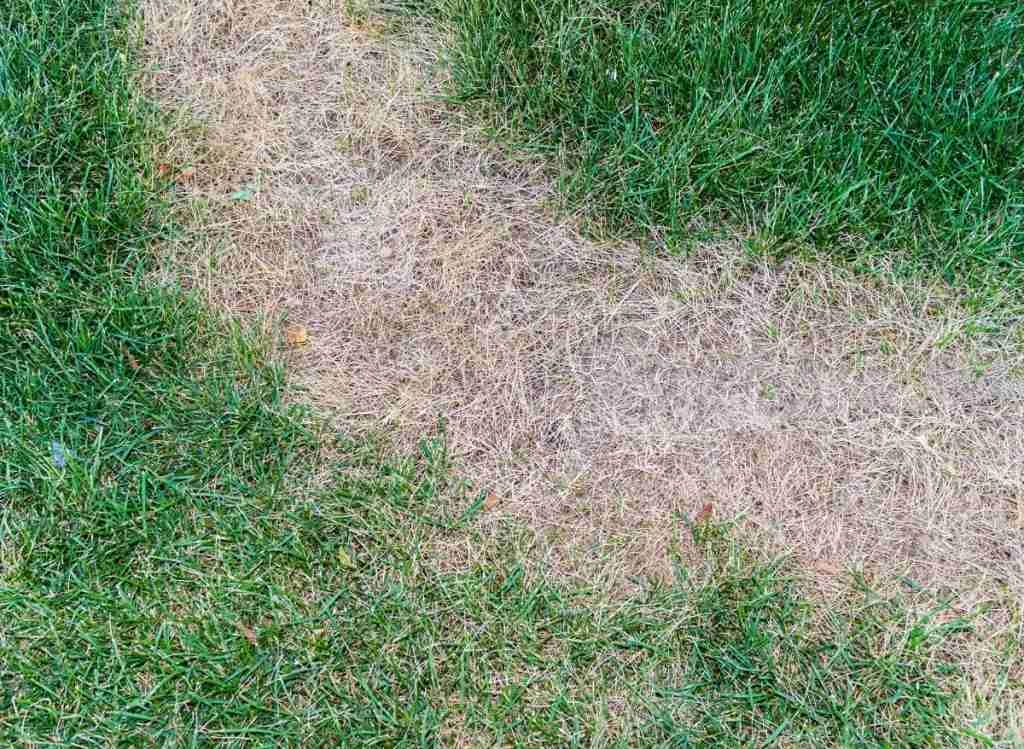This post contains affiliate links.

Having and maintaining green grass is one of the most important goals for every gardener. However, imagine you wake up the following day and find out that all your grass is burned and has turned yellow. You would want to know how to get burnt grass green again.
To get burnt grass green again, first, figure out what caused the burn. Fertilizer and urine burns can be treated with simple watering to flush out and remove the excess salt and nitrogen. Fire and Heat burns require regular, consistent, and deep watering. However, if the grass is completely dead, then you need to reseed it.
Read on to find out what burns your grass and how to quickly and successfully get burnt grass green again.
See also: How To Successfully and Easily Get Rid of Clover Faster.
Understanding What Causes Grass Burn
Relying solely on the appearance of your lawn to determine what is causing the issue can be deceiving.
Understanding is the first successful step to fixing the issue. First, warm-season grass naturally goes dormant during the winter months. So if you live in a warm climate and your lawn turns brown every winter season, you should not worry; it will turn green again by late spring or early summer.
Heat and lack of water will initially drive a lawn into dormancy.
In addition, sometimes, cool-season grasses may turn brown and look dead in summer because of heat and drought.
Whether you live in a rural or highly urban area, your local county extension office is an excellent resource for spot-on lawn advice.
According to the University of Illinois, the minimum amount of water needed to keep the grassroots alive is about 1/3-inch water once in 3 weeks.
In other words, your grass can survive through periods of drought on a surprisingly small quantity of water as long as the water arrives at the root zone. Yes, your lawn will turn brown, but it will keep the roots alive.
See also: Top 16 Best Gardening Books For Beginners
Cause of Grass Burns
Applying too Much Fertilizer lead to too Much Nitrogen
Nitrogen is an excellent way to turn grass into beautiful green grass, but applying too much nitrogen can cause severe damage. Applying too much synthetic fertilizer mainly causes fertilizer burn. A great way to prevent fertilizer burn is to use compost because it has less nitrogen (no synthetic nitrogen).
Keep in mind that grass doesn’t need a ton of nitrogen; it only needs an NPK of 3:1:2 or 4:1:2, according to the University of Illinois Extension Office.
When the entire lawn becomes lightly browned, or streaks of solid brown grass is an indication that you applied too much fertilizer, according to the West Virginia University Extension Service.
How To Get Chemically Burnt Grass Green Again:
The best way to get chemically burnt grass green again is to deeply water every day until the grass turns green, mainly caused by too much. Grass typically needs about an inch of water per week, but to heal chemically burnt grass, you may need to water at least an inch per day. And the water needs to sink deep, about 5 or 6 inches into the soil, and reach the roots.
- If you have a large garden, it might be challenging to water by hand.
- Use a sprinkler.
- Connect a garden hose to a timer and program the timer to come on in the early morning to ensure your lawn gets watered at regular intervals.
- Use a craft stick or a pipe cleaner to check the depth of moisture in the soil and let it run to soak at least 5 inches.
Animal Urine
Animal urine is also high in nitrogen; when dogs urinate on grass, it can cause your grass to change color.
Treat animal urine the same way as fertilizer burns; deeply water the area affected. If possible, use wastewater or rainwater to water the area after your dog urinates quickly.
How To Get Animal Urine Burnt Grass Green Again:
- Examine the roots of the burned grass. If they are still healthy and moist, the damage is at the upper layer only, meaning new growth will be unaffected.
- Water the soil to flush out excess nitrogen if the burning has not reached the roots.
- Do not cut your grass; wait until you have 2 to 3 inches of new growth.
- Rake up yellowed patches of soil where burning from urine has reached the roots, and discard the dead material.
- Turn the soil with a rototiller or metal rake. A rake is usually enough to loosen the soil sufficiently if the area is small.
- Spread grass seed covering the affected areas and water daily for about one week.
- Replace the grass with urine-tolerant grass such as fescue or perennial ryegrass, a tall meadow, or white clover. The good news is that these grass types need less water and less or no fertilizer.
- Use compost or a synthetic fertilizer with lower amounts of nitrogen to fertilize your grass.
- Give your dogs more water to dilute the urine (diluted urine is less likely to carry a high enough nitrogen concentration to burn your grass)
- Ensure you train your dog to only pee in specific places.
See also: 5 Important Zinc Toxicity Symptoms to Look Out for in Your Plants.

Heat Burn
Warm weather is the same as thirst in plants and people. Watering your heat-burnt lawn is one of the best ways to get burnt grass green again.
Heat burn happens when high temperatures cause stress on your lawn, such as mowing in the hottest part of the day.
Sometimes, heat burn can be misidentified as fertilizer burn but requires much deeper watering to treat.
Tips To Avoid Heat Burn:
- Avoid mowing dormant grass.
- Mow your grass between 8 to 10 AM or 4 to 6 PM to avoid the heat of the day.
- Watering your lawn in the morning can save time and money because the fresh morning temperature reduces the quantity of water lost to evaporation.
- Keep your mower’s blades sharp, so they cut the grass cleanly instead of tearing, which stresses the grass out even more.
- Avoid shallow watering because it encourages roots to grow along the top, where they are more likely to get scorched and die. Instead, deepwater your lawn to encourage the roots to grow deep within the soil; therefore, protect it from the heat.
- To reduce heat damage, mow your lawn less often, and remove less grass when you cut.
- Fertilizing your grass with nitrogen-based fertilizers during hot weather encourages green foliage over roots and makes your lawn less tolerant of heat.
See also: Do You Actually Need A License For A Garden Sprinkler? ( Here’s the truth!)
How to Treat Heat Burn:
- Water your lawn early in the morning to help your damaged grass absorb the water.
- Water as deep as 5 to 6” so all the roots have access.
- Be patient – your grass will recover as long as the roots are healthy.
Fire Burn
Usually, fire only affects the top layer of soil; if your grass still has grown deep roots, your lawn will bounce back.
It depends on the type of grass and if the fire got hot enough to kill the roots. Most perennial grass will grow back. Annual types of grass that have completed their life cycle would not grow back. And it may take until the next growing season for the grass to grow back or until it gets rained on or watered.
- Deep waterings.
- Lightly fertilize your grass with compost.
Does Burnt Grass Grow Back?
Generally, your grass will recover over time, but badly heat-burnt grass may die back in places, leaving bare spots. With the proper techniques, you can reduce your lawn’s recovery time and prevent weeds from taking over in the burned and damaged areas of your lawn.
Success at restoring a dead lawn depends on how long the grass has been dead and what caused the death of the grass in the first place. And, generally, any lawn that appears dead for a short period spanning 3 to 5 weeks can be regrown.
How Do You Fix Burnt Grass From Fertilizer?
Fertilize your lawn in early September and avoid fertilizing your lawn during the hot summer months to prevent the risk of burning. During hot, dry conditions, grass usually goes dormant, and applying fertilizer will encourage excessive growth, causing burnt grass.
The best ways to fix burnt grass from fertilizer are leaching the excess fertilizer out of the ground and reseeding dead patches.
- Connect a sprinkler head to a garden hose.
- Rake up and clean the dead grass blades in the fertilizer-burned areas.
- Check the roots of burned grass. If the roots are moist and healthy, the burn only affects the top of the plants, and the grass may recover with watering. However, if the roots are withered and brown, you will need to replace the grass.
- Turn the soil with a tiller to loosen it and break up clumps to prepare it for new sod.
- Place a patch of sod onto the prepared soil, pressing the edges down firmly to make sure it thoroughly penetrates the soil beneath.
- Each morning, water the sodded areas for about a week. Generally, watering daily is necessary until you see new growth or the sod has rooted into the soil.
- After the new grass is set, you can cut back watering to once every two weeks.
See also: Here’s How to Easily Make Money Gardening
How Long Does It Take For Dead Grass to Turn Green Again?
How long it takes for dormant grass to start growing again depends on the weather, temperature, day length, grass species, watering, soil fertility, pH, the poison that might be present, light, salinity, and soil compaction.
When the lawn goes brown in the winter, all those grass leaves are dead, but the roots are alive. And the plants go dormant but not dead.
If it is dormant, once the temperature and moisture conditions return to normal, it will green up soon.
In general, root dormancy breaks 3 to 4 weeks before top green growth begins.
See also: Here’s How to Start a New Garden From Scratch
Wrapping Up
How to get burnt grass green again will depend on the cause of the burn. With the proper method, you can get burnt grass green again. First, figure out the causes of burnt grass. The leading causes of burnt grass are:
- Applying too Much Fertilizer lead to too Much Nitrogen
- Animal Urine
- Heat Burn
- Fire Burn
So, before tearing your lawn up and calling the lawn technician, consider your type of grass, the cause of the burn, and local weather patterns. And remember, on average, it takes about three to four weeks to get dormant grass again.


